How Many Rest Days Per Week for Optimal Fitness?(Finding the Right Balance)
In this article, we will explore how many rest days per week you truly need to optimize your fitness, enhance recovery, and improve fitness results.
“How many rest days per week?” It’s a question that pops up in the mind of every fitness enthusiast at some point. Here’s a light joke to kick things off: Why did the gym-goer take a day off? Because even muscles need a break from being awesome! But in all seriousness, the amount of rest you take is just as important as the time you spend working out.
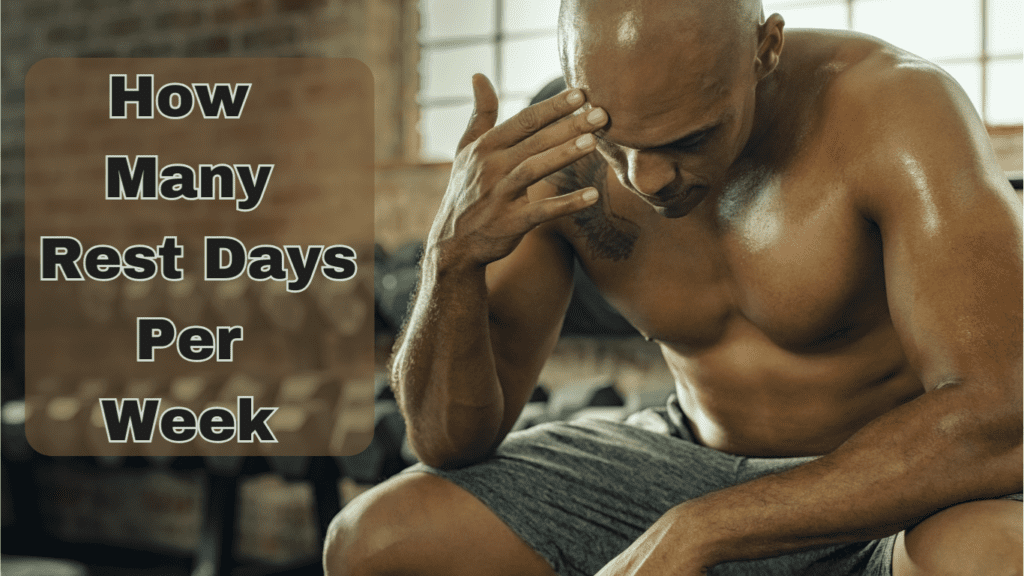
Interesting fact: Muscles don’t actually grow during exercise; they grow when you rest. Surprising, right? You break down muscle fibers during a workout, and it’s during rest that they repair and grow stronger. This leads to one of the most important aspects of fitness that often gets overlooked: the need for rest. Whether you’re lifting weights, doing CrossFit, or training for a marathon, how you balance work and rest is key to your overall progress.
The Importance of Rest in Fitness
In today’s fitness culture, a common misconception is the idea that “more is better.” More reps, more hours in the gym, more days of training—all in the hope that it will lead to quicker results. The reality, however, is that without adequate recovery, you’re not allowing your body to heal and grow. In fact, rest is just as vital as your workout routine itself. Overtraining without proper recovery can lead to fatigue, injuries, and burnout. So, while it’s tempting to think that pushing harder will get you there faster, rest is an essential part of any effective fitness program.
So, how many rest days per week should you actually take? The answer depends on a variety of factors like your training type, your goals, and your fitness level. In this article, we’re going to break it down by fitness discipline—whether you’re into bodybuilding, CrossFit, or powerlifting—and also by skill level—whether you’re a beginner, intermediate, or advanced. This way, you can determine the ideal number of rest days for your specific situation.
Subscribe And Get Our Free E-Book:Unlocking The Power Of Nutrition-Supplements, Substitutes, and Superfoods!
We’ll be pulling information from experienced fitness professionals, scientific research, and practical experience to give you a clear, evidence-based answer. Whether you’re trying to build muscle, improve endurance, or just stay in shape, knowing how many rest days per week you need will help you get the most out of your workouts.
The goal here isn’t just to tell you to take a break, but to explain why and how proper rest is crucial for muscle growth, recovery, and long-term health. This is where fitness success truly lies—in the balance between pushing your limits and giving your body the time it needs to repair and grow stronger.
By the end of this article, you’ll have a well-rounded understanding of the importance of rest and how it varies depending on what kind of training you do and your level of experience. Whether you’re a beginner who’s just starting out, an intermediate looking to push through plateaus, or an advanced athlete fine-tuning your routine, we’ll provide a comprehensive approach to help you figure out how many rest days per week are ideal for you.
Why Rest Days Matter
“How many rest days per week?” Let’s kick off this section with a little more humor: Why did the weightlifter bring a ladder to the gym? Because they heard they needed to take their workouts to the next level—but forgot to include rest days!
Here’s an interesting fact: Studies show that muscle recovery can take anywhere from 24 to 72 hours, depending on various factors like workout intensity and individual fitness levels. This highlights just how vital taking brake is for anyone engaged in regular physical activity.
How Often Should You Train Video
Physiological Benefits of Rest Days
So, why exactly do rest days matter? The answer lies in physiological benefits that are essential for effective training. When you work out, you create tiny tears in your muscle fibers. It’s during the recovery phase that your body rebuilds these fibers, making them thicker and stronger. This process is known as muscle adaptation. If you fail to allow adequate recovery time, you’re not just hindering muscle growth; you’re setting yourself up for failure.
Muscle Repair: After a workout, the body shifts its focus to repairing the damaged muscle fibers. This involves the synthesis of new proteins, which are crucial for muscle recovery. When you rest, the body releases hormones like testosterone and growth hormone, which play a significant role in muscle repair and growth. Without sufficient rest, these processes become disrupted, and you may not see the gains you’re working hard for.
CNS Recovery: Another crucial aspect is the recovery of the central nervous system (CNS). Intense training doesn’t just stress your muscles; it also puts a significant load on your CNS. A fatigued CNS can lead to reduced performance, poor coordination, and increased risk of injury. Regular rest days give your CNS the chance to recover, ensuring that you remain sharp and focused during your workouts.
Hormone Balance: Hormonal balance is also affected by the amount of rest you take. Overtraining can lead to elevated cortisol levels—often referred to as the stress hormone—which can negatively impact your mood, sleep, and overall health. On the flip side, sufficient rest helps keep your hormones in check, allowing for better performance, mood stability, and recovery.
Mental Well-Being: Don’t underestimate the importance of mental recovery. Intense training can lead to mental fatigue, which may diminish your motivation and enthusiasm for workouts. Incorporating rest days allows your mind to recharge, making it easier to stay committed to your fitness goals. Remember, fitness is not just a physical endeavor; it’s a mental one too.
Overtraining Risks
Now that we understand why rest days are crucial, let’s talk about the risks of not resting enough. Many individuals underestimate the negative impact of insufficient rest, often thinking that if they push harder, they’ll achieve their goals faster. However, this mindset can lead to a phenomenon known as overtraining syndrome.
Overtraining can manifest in various ways, including:
- Burnout: The most common outcome of inadequate rest is burnout. This leads to a lack of motivation and decreased performance. When your body is fatigued, pushing through workouts can feel like an uphill battle, and eventually, you may find yourself dreading your time at the gym.
- Injury: One of the most severe risks of not incorporating enough rest days is injury. Overuse injuries, like tendonitis or stress fractures, often occur when muscles and joints don’t get enough recovery time. Without adequate rest, your body can’t properly heal from the micro-traumas created during workouts, making it more susceptible to injuries.
- Diminishing Returns: Another downside of insufficient rest is the diminishing returns effect. Instead of seeing improvements, you might find that your performance plateaus or even declines. This can lead to frustration and a sense of defeat, as all your hard work seems to be for nothing. When you don’t allow your body time to recover, you’re essentially training without purpose.
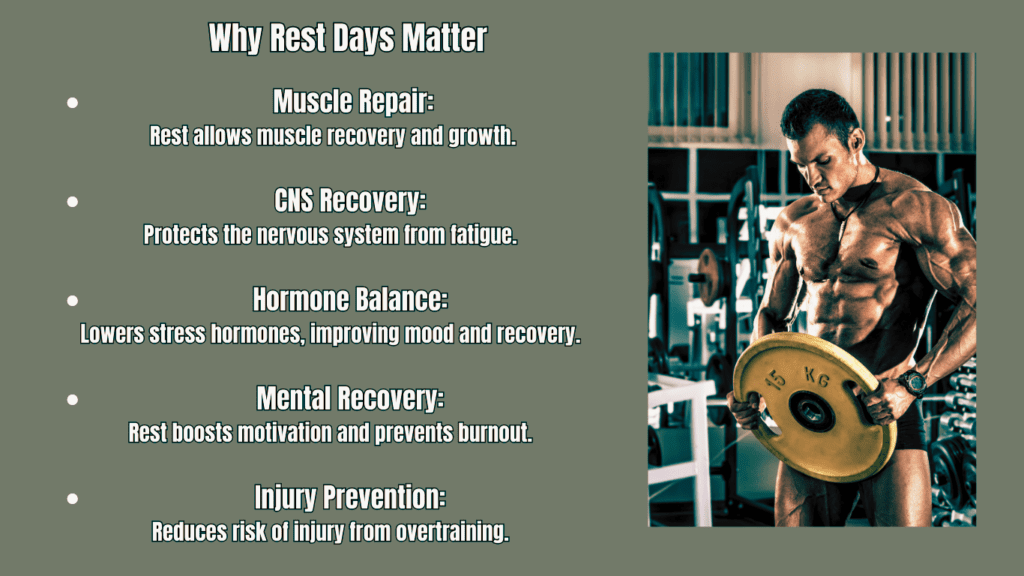
Understanding how many rest days per week you should take isn’t just about preventing burnout or injuries; it’s also about maximizing your overall fitness results. By allowing for proper recovery, you enable your body to adapt, grow, and come back stronger for your next workout.
Incorporating rest days into your training routine can lead to more significant muscle growth, improved performance, and a healthier mental state. Remember, fitness is a marathon, not a sprint. Prioritizing rest will set you up for long-term success and sustainability in your fitness journey.
How Many Rest Days Per Week? (General Guidelines)
Did you know that studies have shown that well-timed rest can improve performance by as much as 30%? This means that taking adequate rest days can significantly enhance your workout efficiency and results. Understanding how many rest days per week you should take is crucial for making the most of your training sessions!
Beginners
For those just starting their fitness journey, the body is adapting to new stresses and challenges. Beginners typically require more recovery time due to their muscles, joints, and connective tissues not being accustomed to intense physical activity. The introduction of strength training or high-intensity workouts can lead to delayed onset muscle soreness (DOMS), which is the muscle pain felt after unfamiliar exercise.
Beginners should aim for 2 to 3 rest days per week. This allows ample time for recovery, adaptation, and minimizes the risk of injury. By alternating workout days with rest days, beginners can gradually acclimate their bodies to the demands of exercise.
A simple training split for beginners might look like 3 days on, 1 day off. For instance, you could work out on Monday, Wednesday, and Friday, with rest days on Tuesday, Thursday, and the weekend. This structure not only promotes recovery but also helps in managing soreness and fatigue.
The science behind this is straightforward: when you exercise, your muscles undergo micro-tears that require time to repair. For beginners, this repair process can take longer as their bodies are still adjusting to the new physical demands. By incorporating rest days, they allow their bodies to recover effectively, leading to better long-term results.
Intermediate
As you gain experience and build a foundation, your body becomes more conditioned and capable of handling higher volumes of training. Intermediate lifters or athletes can usually handle more frequent training sessions while still needing adequate rest for continued progress.
For this group, 1 to 2 rest days per week is often sufficient, depending on the intensity and volume of training sessions. Those focusing on strength may benefit from more rest than someone engaged in endurance training.
An effective training split for intermediates could follow a push-pull-legs routine. This would involve working out on push days (chest, shoulders, triceps), pull days (back, biceps), and legs, followed by a rest day after each cycle. So, you might train on Monday (push), Tuesday (pull), Wednesday (legs), rest on Thursday, and repeat.
The reasoning behind this structure is that as your body adapts, it can handle greater loads, but rest is still crucial for muscle recovery and overall performance. The adaptation process involves hormonal balance, muscle repair, and central nervous system recovery, all of which are optimized with appropriate rest.
Advanced
Advanced trainees often push their bodies to higher intensities and volumes, which requires a strategic approach to rest. While these individuals usually have well-conditioned bodies, the cumulative stress from high training loads can lead to fatigue and the risk of overtraining if not managed correctly.
Advanced athletes might benefit from 1 day of complete rest each week, along with additional active recovery days. These could include activities like yoga, light cardio, or mobility work that helps promote recovery without the strain of a full workout.
A common training schedule for advanced lifters might consist of 6 days of training, with 1 full rest day and 1 active recovery day. For example, you could train hard Monday through Saturday, take Sunday off completely, and incorporate light activities or stretching on an active recovery day.
The rationale for this approach lies in the fact that while advanced trainees can handle significant workloads, their bodies still need time to recover fully. The intense workouts they perform result in substantial muscle breakdown, requiring not just rest but also active recovery to flush out toxins, promote blood flow, and prepare for subsequent sessions.
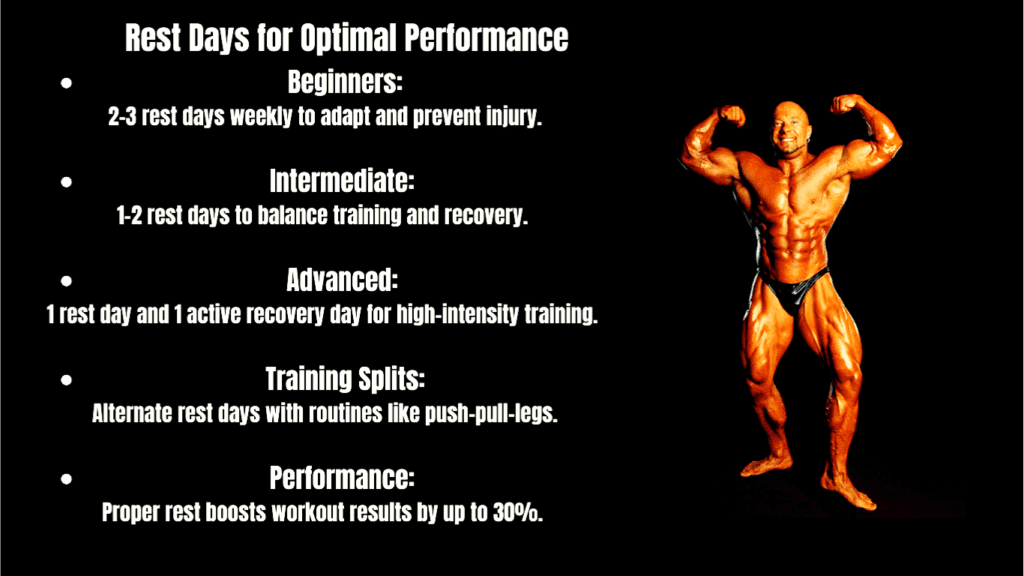
Ultimately, finding the right balance of rest days tailored to your individual needs is key to achieving your fitness goals. Whether you’re just starting, progressing through intermediate levels, or pushing the limits as an advanced athlete, recognizing the importance of rest will help you optimize your performance and enhance your overall well-being. Understanding how many rest days per week you need is essential, as listening to your body and allowing it the time it needs to recover will lead to sustainable growth and success in your fitness journey. Make sure to reflect on your own training routine to determine the best approach for how many rest days per week will suit your needs.
Rest Days for Different Fitness Disciplines
Why did the gym close down? Because it just didn’t work out! But while lifting weights is essential, knowing how much resting per week to incorporate into your routine is just as crucial. Different fitness disciplines require specific approaches to rest to maximize performance and recovery.
Bodybuilding
Bodybuilding focuses on muscle hypertrophy and aesthetics, meaning the aim is not just to lift heavy but also to develop a well-defined physique. Achieving this requires both high training volume and quality recovery. For bodybuilders, the recommendation is typically 1 to 2 rest days per week, depending on the training split and the level of muscle fatigue. It’s essential to listen to your body and adjust rest days accordingly.
Pro bodybuilders often emphasize the importance of using these rest days to optimize nutrition. Increasing protein intake during recovery can support muscle repair and growth. Additionally, some may suggest incorporating supplements, like branched-chain amino acids (BCAAs) or glutamine, to enhance recovery. An example training split might look like a 5-day routine with training sessions from Monday to Friday, followed by rest on Saturday and Sunday. This approach allows for targeted muscle training while ensuring adequate recovery.
CrossFit
Next up is CrossFit, which involves high-intensity functional movements that can be taxing on the central nervous system (CNS) and joints. Given the intensity and variety of workouts, the recommendation here is 2 rest days per week. These rest days should include active recovery options such as mobility work, swimming, or even leisurely walking to keep the body engaged without overexerting it.
Elite CrossFit athletes often share insights about the importance of mobility and injury prevention through proper rest. They emphasize that focusing on flexibility and joint health during recovery can make a significant difference in performance. A common training split for CrossFit might be structured as 3 days on, 1 day off, followed by 2 days on and another day off. This pattern allows athletes to maximize their training while also prioritizing recovery.
Powerlifting
Now let’s talk about Powerlifting, which centers on strength training with heavy compound lifts. This discipline places significant stress on muscles and the CNS, making adequate recovery vital. For powerlifters, the recommendation is generally 2 to 3 rest days per week to allow for complete CNS recovery and to prevent injury.
Powerlifters often plan their rest days around their heavy squat, bench, and deadlift days. Many powerlifters utilize the concept of “deload weeks,” where the intensity of training is reduced to aid recovery while still maintaining a training routine. An example training split could involve 4 days of heavy lifting with 3 rest days or low-intensity active recovery days, which might include light cardio or mobility drills. This allows the body to recover from the heavy lifting sessions while still staying active.
Understanding how many rest days per week you should take varies depending on your specific fitness discipline and goals. It’s not just about the number of days off but how you use those days to support your overall training objectives. Whether you’re focused on bodybuilding, CrossFit, or powerlifting, recognizing the importance of rest is key to enhancing your performance and achieving your fitness goals.
Incorporating effective rest days not only helps in recovery but also aids in mental well-being, which can often be overlooked in fitness routines. When you allow your body to recover properly, you’ll find that you return to your workouts feeling stronger and more focused. This holistic approach to training ensures you get the most out of your efforts, making every workout count.
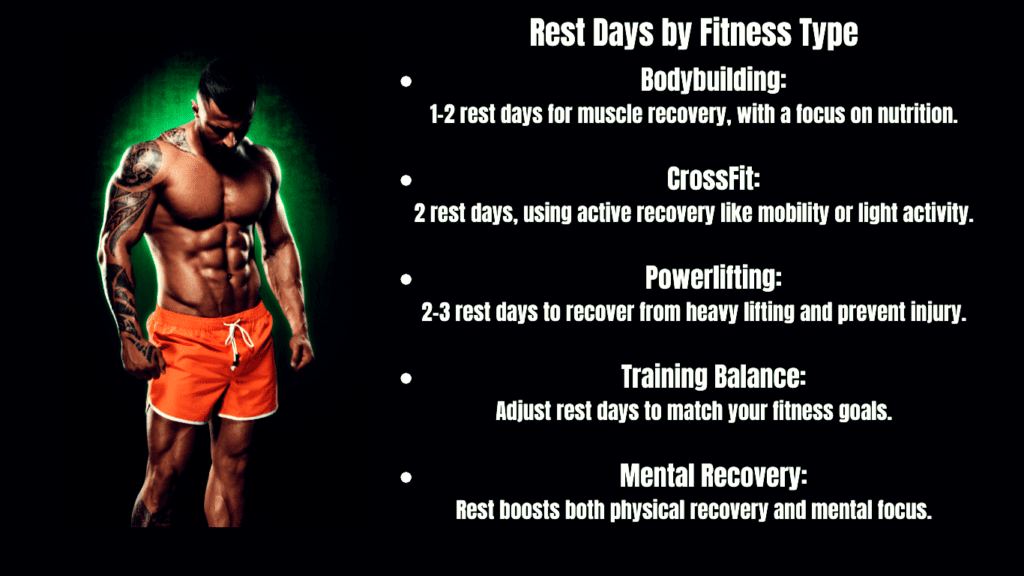
Ultimately, knowing how many rest days per week is essential to your success in any fitness journey. It’s about finding the right balance that aligns with your specific discipline and personal goals. As you continue to train, remember that rest is not a sign of weakness but rather a crucial component of strength. Listen to your body, respect your recovery needs, and you’ll be well on your way to achieving your fitness aspirations.
Factors That Influence Rest Days
Why did the gym hire a new coach? Because they wanted to work on their “rest” day! Understanding how many resting days per week you need is crucial for optimizing your training routine. Several factors influence the number of rest days you should incorporate into your regimen. Let’s explore these key considerations.
Intensity and Volume
Intensity and Volume play a significant role in determining your recovery needs. The harder and longer you train, the more recovery your body requires. High-intensity workouts, such as heavy lifting or intense cardio sessions, create more muscle damage and fatigue than low-intensity activities like walking or light stretching. This means that if you’re pushing yourself in the gym, you may need to take more rest days to allow your muscles to recover fully. For instance, athletes who engage in high-intensity interval training (HIIT) might find that incorporating 2 to 3 rest days per week helps them recover adequately and perform better in their next workouts.
Age
Age is another important factor. As we age, our bodies typically recover more slowly. This means older athletes might need more rest days than their younger counterparts. The natural decline in hormone levels and changes in muscle composition can impact recovery rates. Therefore, if you’re an older athlete, you might benefit from evaluating your routine and possibly increasing your rest days to ensure optimal recovery.
Nutrition and Sleep
Nutrition and Sleep also play crucial roles in recovery. Adequate protein intake helps repair muscle tissue, while hydration is vital for overall performance and recovery. Research suggests that athletes should aim for a balanced diet that supports their training needs. Additionally, getting 7 to 9 hours of quality sleep each night can significantly reduce the need for extra rest days. Sleep is when most muscle recovery and growth occur, so prioritizing it is essential. If you’re not fueling your body properly or skimping on sleep, you may find yourself needing more rest days to compensate for the lack of recovery.
Stress and Lifestyle
Stress and Lifestyle factors are also vital to consider. External stressors, whether from work or family life, can impact your recovery abilities. If life stress is high, your body may require additional rest days to cope with the extra demands placed on it. Stress can increase levels of cortisol, a hormone that can interfere with muscle recovery and growth. Therefore, if you’re feeling overwhelmed outside the gym, it may be wise to incorporate more rest days into your schedule.
In summary, determining how many resting you should take involves considering various factors, including the intensity and volume of your workouts, your age, your nutrition and sleep quality, and your overall lifestyle and stress levels. Each of these elements can significantly influence your recovery needs and, ultimately, your performance in the gym.
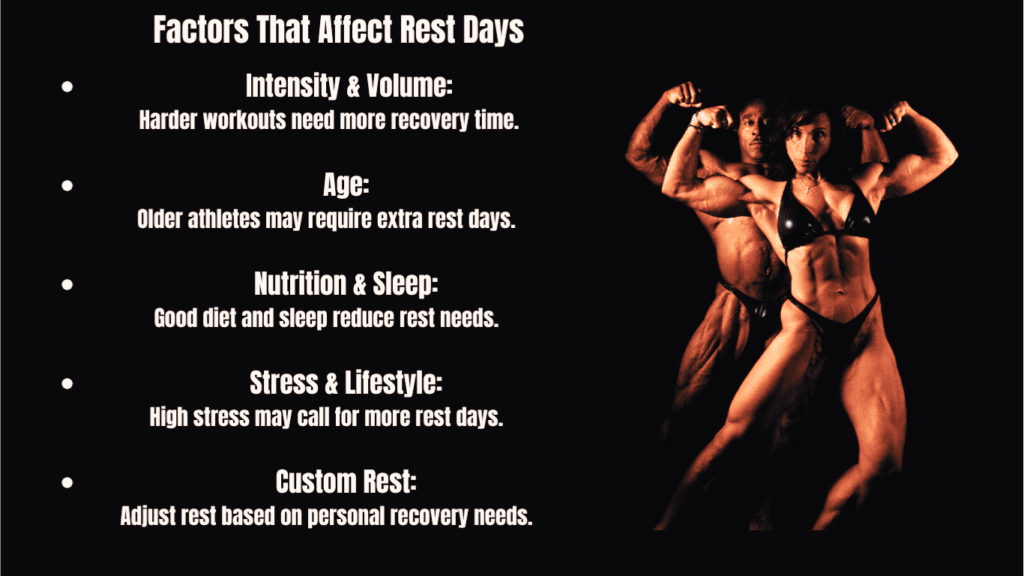
By understanding these factors, you can create a more tailored training program that not only meets your fitness goals but also respects your body’s need for recovery. Remember, rest is not just an afterthought; it’s an integral part of any successful fitness routine. So as you continue to train, be mindful of these influences and adjust your rest days accordingly. Doing so will help ensure you remain at your best, both physically and mentally.
Ultimately, knowing how many rest days per week you should take is about striking the right balance for your individual needs. Listening to your body, monitoring your performance, and adapting your training schedule will lead to better results and a healthier fitness journey.
Take the time to evaluate how these factors apply to you, and don’t hesitate to adjust your rest days as needed. With the right approach, you’ll be well on your way to achieving your fitness aspirations while keeping your body in peak condition.
Active Recovery vs. Complete Rest
Why did the gym teacher go to jail? Because he got caught pushing up daisies! While that’s a lighthearted take, knowing how many rest days per week you need is vital for your fitness journey. One aspect of recovery that often confuses athletes is the difference between active recovery and complete rest. Let’s break it down to help you make informed choices about your recovery routine.
Active Recovery
Active Recovery refers to engaging in low-intensity activities that promote blood flow and help the body recover without putting additional strain on it. This can include activities like light cardio, yoga, or mobility exercises. The key here is to keep moving without overexerting yourself. Active recovery is particularly beneficial on days when you’re feeling soreness but not full fatigue. For instance, if you’ve just completed a heavy leg workout and your muscles feel tight but not completely drained, a light walk or a gentle yoga session can help ease muscle soreness and improve flexibility.
Active Rest Days in Fitness and Bodybuilding Charts:
| Aspect | Description |
|---|---|
| Definition | Active rest days involve light physical activities that aid recovery without high intensity. |
| Benefits | – Improved blood flow – Reduced muscle soreness – Enhanced mental refreshment – Flexibility and mobility enhancement |
| Recommended Frequency | 1 to 2 active rest days per week, depending on training intensity. |
| Fitness Level | Examples of Active Rest Activities | Intensity Level | Duration |
|---|---|---|---|
| Beginners | – Walking | Low | 20-30 minutes |
| – Gentle yoga or stretching | 20-30 minutes | ||
| – Light cycling | 20-30 minutes | ||
| ——————- | ———————————————————— | ———————— | ————————— |
| Intermediate | – Light jogging | Moderate | 30-45 minutes |
| – Swimming (easy pace) | 30-45 minutes | ||
| – Recreational sports (casual play) | 30-45 minutes | ||
| ——————- | ———————————————————— | ———————— | ————————— |
| Advanced | – Active mobility work (dynamic stretching, foam rolling) | Low | 30 minutes |
| – Hiking (moderate trails) | Moderate | 60 minutes | |
| – Team sports (practice without competition intensity) | 60 minutes |
Additional Tips for Active Rest Days
- Listen to Your Body: Adjust activities based on how you feel; the goal is to promote recovery, not fatigue.
- Stay Hydrated: Ensure you’re drinking enough water to support recovery.
- Focus on Enjoyment: Choose activities you enjoy to keep your motivation high and make recovery feel less like a chore.
Complete Rest
On the other hand, Complete Rest means taking a break from any physical activity. This is necessary when you’re experiencing mental burnout, extreme fatigue, or joint pain. Complete rest allows your body to recuperate fully and can be crucial for preventing injuries. If you find yourself feeling mentally exhausted or if you’re struggling with joint pain after an intense training cycle, it’s a sign that you might need a full day or two off from any workouts.
Choosing Between Active Recovery and Complete Rest
When deciding between active recovery and complete rest, consider the signals your body is sending you. If you’re experiencing mild soreness but feel generally energized, active recovery might be the right choice. Engaging in light activities can actually enhance recovery by increasing circulation, which helps deliver nutrients to your muscles and aids in the removal of metabolic waste.
Conversely, if you’re feeling run down mentally or physically, or if you notice persistent pain in your joints or muscles, it’s best to opt for complete rest. Ignoring these signals can lead to overtraining and injuries, which can sideline you for much longer than a couple of rest days.
Finding Balance
For many athletes, finding the right balance between active recovery and complete rest is essential for sustainable progress. Recognizing the difference can also help you manage your training schedule more effectively. It’s not just about how many rest days per week you take, but also how you choose to spend those days. Incorporating active recovery when appropriate can keep you in motion while still allowing your body to heal and adapt.
A great way to implement active recovery is by scheduling it into your routine on days following particularly intense workouts. For instance, if you’ve had a tough week with high-intensity training, consider setting aside a day for activities like cycling at an easy pace, swimming, or doing some light stretching or yoga. This can be a refreshing way to engage your body without pushing it to its limits.
Understanding how many rest days per week you should take involves not just knowing when to rest completely but also recognizing the benefits of active recovery. Each approach has its place in a well-rounded fitness regimen. The key is to listen to your body and respond to its needs, ensuring that you stay on track with your fitness goals while avoiding burnout or injury.
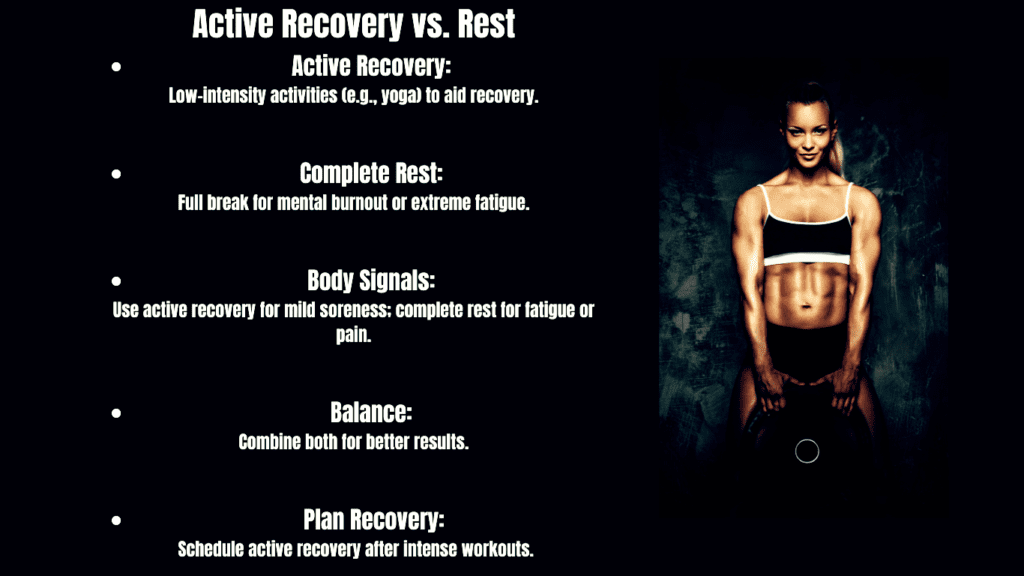
By incorporating both active recovery and complete rest appropriately, you’ll find yourself better prepared for your workouts, more energized, and less likely to face setbacks. This balanced approach will ultimately support your long-term fitness journey, allowing you to maintain progress and enjoy the process.
So next time you’re planning your week, remember to consider both active recovery and complete rest in relation to how many rest days per week you need. This mindful approach will help you optimize your training and stay on the path toward achieving your fitness aspirations.
How to Know You Need More Rest
Why did the personal trainer bring a ladder to the gym? Because they wanted to reach new heights! When it comes to achieving your fitness goals, knowing how many rest days per week you need is essential for maintaining progress. However, sometimes the biggest challenge is recognizing when you need more rest. Understanding the signs of overtraining and acknowledging the importance of mental health can help you make informed decisions about your recovery.
Signs of Overtraining
One of the first indicators that you might need more rest is fatigue. If you find yourself feeling consistently tired, even after a good night’s sleep, this could be a sign that your body is not recovering adequately. Irritability is another common symptom. If you notice that you’re more easily frustrated or upset than usual, it could indicate that your body is under stress from training. These feelings often stem from the body’s inability to keep up with the demands being placed on it.
Additionally, declining performance is a clear warning sign that you may need to take a step back. If workouts that once felt manageable are now leaving you exhausted, or if you’re struggling to lift the same weights or complete your usual routine, it’s time to listen to your body. Lack of motivation can also signal overtraining. If you’re finding it difficult to muster the enthusiasm to hit the gym or complete your workouts, your body might be asking for a break. Lastly, if you experience poor sleep—whether it’s trouble falling asleep or staying asleep—this could be another indication that you need to reassess your training schedule and incorporate more rest.
Mental Health Considerations
While physical signs are important, the mental aspect of rest should not be overlooked. Burnout is a very real phenomenon that can stem from relentless training without adequate recovery. When you push yourself too hard without allowing time for mental recovery, it can lead to a decline in motivation and enjoyment in your workouts. Recognizing that rest is not a sign of weakness, but rather a necessary component of a balanced fitness routine, can significantly improve your outlook on training.
Taking a day off can provide a fresh perspective and help you regain your motivation. When you’re mentally refreshed, you’re likely to approach your workouts with renewed focus and energy. This can lead to more productive training sessions and better results over time. Sometimes, stepping back for a day or two can help you return to the gym feeling stronger and more dedicated.
Listening to Your Body
Understanding how many rest days per week you need is about being in tune with your body’s signals. If you’re experiencing any of the signs mentioned, it’s crucial to consider your training intensity and schedule. Remember, rest days are not just about physical recovery; they also play a significant role in mental well-being. Allowing yourself the grace to take a brake when needed can lead to more sustainable progress and greater enjoyment of your fitness journey.
Consider keeping a training journal where you can log your workouts, energy levels, and mood. This can help you identify patterns and better understand when you might need more rest. If you notice a recurring trend of fatigue, irritability, or lack of motivation, take it as a cue to adjust your training plan.
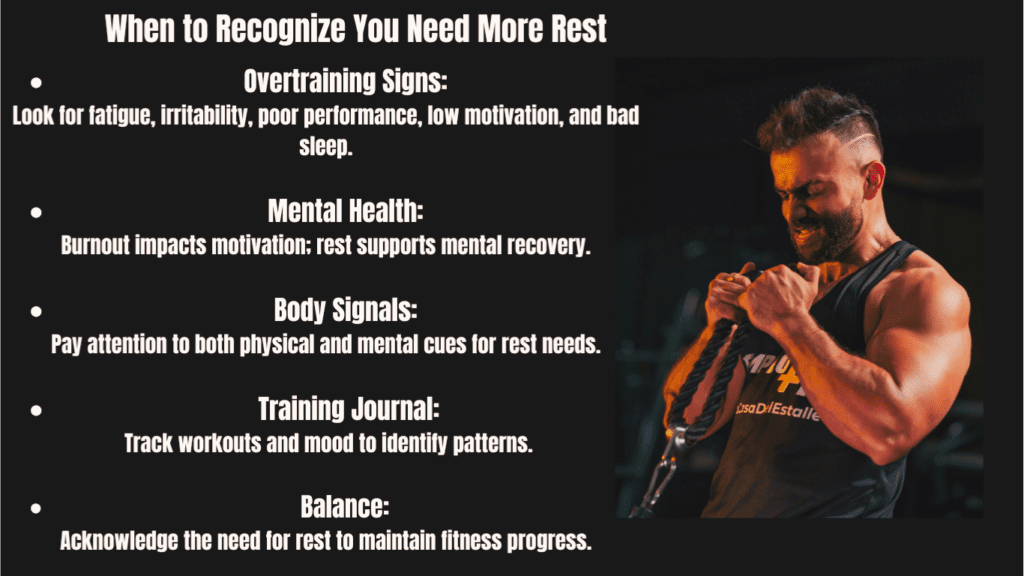
Ultimately, recognizing the need for more rest is a skill that can greatly benefit your overall fitness journey. It allows you to maintain a healthy balance between training and recovery, which is essential for long-term success.
In conclusion, being aware of the signs of overtraining and prioritizing mental health can help you determine how many rest days per week are necessary for your well-being. By listening to your body and understanding when it’s time to rest, you can enhance your training experience and achieve your fitness goals more effectively. Remember, rest is an integral part of the process, not an obstacle. Embrace it, and you’ll find yourself stronger and more motivated in the long run.
Recognizing Overtraining: Signs and Recovery Strategies Chart
| Signs of Overtraining | Description | Recovery Strategies |
|---|---|---|
| Persistent Fatigue | Feeling tired despite getting adequate sleep. May affect daily activities and workouts. | – Prioritize sleep hygiene – Incorporate naps |
| Irritability | Increased frustration or mood swings that are unusual for you. | – Practice mindfulness or meditation – Engage in leisure activities |
| Declining Performance | Noticeable drop in workout performance, such as decreased strength or endurance. | – Adjust training intensity – Consider periodization |
| Lack of Motivation | Difficulty feeling enthusiastic about workouts, or feeling like skipping them altogether. | – Change up your routine – Set new, achievable goals |
| Poor Sleep Quality | Trouble falling asleep, staying asleep, or feeling unrefreshed upon waking. | – Limit screen time before bed – Establish a calming pre-sleep routine |
| Increased Heart Rate | Elevated resting heart rate, indicating stress on the body. | – Include more low-intensity cardio – Monitor heart rate variability (HRV) |
| Frequent Illness | Higher susceptibility to colds or other illnesses due to a compromised immune system. | – Focus on nutrition and hydration – Ensure adequate vitamin intake |
| Chronic Muscle Soreness | Prolonged soreness that doesn’t subside after a few days. | – Incorporate active recovery days – Utilize foam rolling and stretching |
| CNS Fatigue | Feelings of mental fatigue, poor focus, or cognitive decline during workouts. | – Schedule complete rest days – Engage in activities that promote relaxation, like yoga |
Key Points to Remember
- Listening to Your Body: Pay attention to these signs and take action accordingly.
- Recovery is Multi-Faceted: Focus not only on physical recovery but also on mental and emotional health.
- Self-Experimentation: Track your symptoms and recovery strategies to find what works best for you.
Customizing Rest Based on Personal Experience
Did you know that even elite athletes often adjust their training schedules based on how they feel? It’s true! This highlights the importance of personalizing your fitness routine, especially when it comes to understanding how much brake you truly need. Customizing your rest days can lead to better performance and overall well-being, so let’s dive into how you can tailor your recovery based on your unique experiences.
Self-Experimentation
One of the best ways to find out how many rest days work for you is through self-experimentation. Start by tracking how you feel on your rest days and how quickly you recover after workouts. Keep a journal or use a fitness app to log your training sessions, energy levels, and overall performance. This data will give you valuable insights into your body’s needs. Are you bouncing back quickly after intense sessions, or are you still feeling fatigued? Recognizing these patterns will help you determine the optimal number of rest days.
For instance, after a tough week of training, take note of how you feel the following week. If you’re feeling energized and ready to hit the gym harder, it may be a sign that you can reduce your rest days. Conversely, if you find yourself dragging or experiencing lingering soreness, it might be time to increase your rest. This process of self-reflection and adaptation is key to achieving your fitness goals.
Tips for Adjusting Rest
Adjusting your rest days based on personal progress is crucial for maximizing your training effectiveness. Here are some practical tips to help you tailor your rest schedule:
- Listen to Your Body: Pay attention to how you feel. If you’re energized and motivated, you might be able to handle more training. If you’re feeling worn out or irritable, it’s likely time to take an extra rest day.
- Set a Baseline: Start with a standard guideline—perhaps 2 rest days per week if you’re a beginner. As you track your progress, you can adjust this number based on your recovery rates and performance levels.
- Monitor Intensity: If you have a particularly intense week, consider adding an extra rest day. High-intensity workouts demand more recovery, so don’t hesitate to listen to what your body is telling you.
- Incorporate Recovery Techniques: Sometimes, you may not need to take a full rest day. Instead, you can implement active recovery techniques on lighter days. This can help you stay engaged while still allowing your body to recover.
- Stay Flexible: Your schedule may vary from week to week. Life can be unpredictable, so be ready to adjust your rest days as needed. Flexibility in your training plan will help you maintain consistency over the long term.
- Consult Professionals: If you’re unsure about your recovery needs, consider consulting with a fitness professional or a coach. They can offer personalized advice based on their expertise and experience.
Incorporating these strategies will not only enhance your recovery but will also keep you motivated and engaged in your fitness journey. Remember, it’s all about finding the right balance for you.
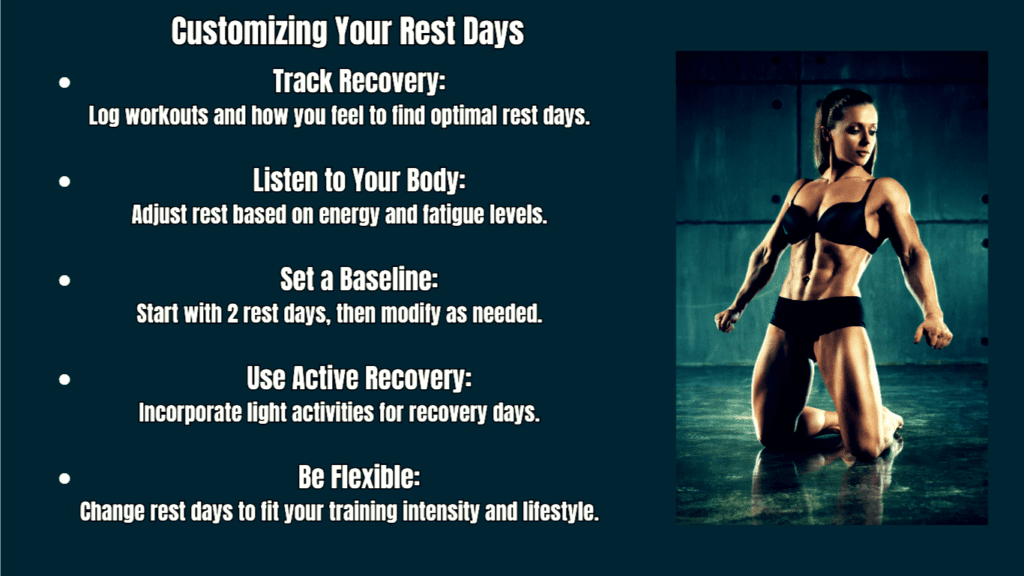
Ultimately, understanding how many resting days per week you need is a dynamic process that can change as you progress in your fitness journey. By practicing self-experimentation and tracking your performance, you’ll be better equipped to customize your rest days effectively.
So, the next time you’re feeling great, remember that it’s okay to push yourself a bit harder, but also know that taking a break when needed is just as important. As they say, “Resting is not a sign of weakness; it’s a sign of wisdom.”
Why did the gym close down? Because it just couldn’t keep its weights up!
Final Thoughts on How Many Rest Days Per Week: Key Takeaways and FAQs
As we wrap up our discussion on how many rest days per week you should take, it’s essential to summarize the key points we’ve covered. Understanding rest is crucial for optimizing performance, preventing injury, and supporting overall health. Let’s recap the highlights of our journey through this important topic.
Key Points Summary
- Rest Varies by Skill Level: Beginners typically need more rest due to their bodies adapting to new stresses, while advanced athletes may require fewer days off but must be strategic about recovery.
- Discipline Matters: Different fitness disciplines have unique demands. Bodybuilders may need 1-2 rest days to support muscle growth, while CrossFit athletes might benefit from 2 rest days due to high-intensity training. Powerlifters often require 2-3 rest days to allow for recovery from heavy lifts.
- Individual Factors: Factors such as age, training intensity, nutrition, and lifestyle stress influence how many rest days you need. Older athletes may require more recovery time, while those with high-stress lifestyles might need additional rest.
These points emphasize why understanding how many rest days per week is critical for your fitness journey. It’s not a one-size-fits-all approach; instead, it’s about finding what works best for you.
Listen to Your Body
One of the most important takeaways is to listen to your body. Your body communicates its needs, so pay attention to signals of fatigue, irritability, or lack of motivation. Experiment with your rest days, adjusting them based on how you feel. Avoid the trap of thinking that training harder without adequate rest will yield better results. Balance is essential for long-term success.
We encourage you to share your experiences in the comments below. What have you learned about your own recovery needs? Have you found specific active recovery exercises helpful? Feel free to ask for recommendations on related topics like mental health and fitness!

FAQs
- Can I do light exercise on rest days? Yes, light exercise such as walking, yoga, or mobility work can be beneficial. This is often referred to as active recovery and can help improve blood flow and reduce muscle soreness.
- How do I prevent feeling guilty about rest days? Understand that rest is an essential part of training. Recognize that taking brake will ultimately help you perform better in your workouts and lead to long-term success.
- What’s the difference between overtraining and normal fatigue? Overtraining involves persistent fatigue, irritability, decreased performance, and a higher risk of injury. Normal fatigue usually resolves with taking a brake and does not significantly affect performance or mood.
- How many rest days should I take if I’m just starting out? Beginners should aim for 2-3 rest days per week to allow their bodies to adapt to new physical activity.
- Is it okay to combine rest days with light activities? Absolutely! Engaging in light activities on rest days can aid recovery without putting too much stress on your body.
- Can my nutrition affect how many rest days I need? Yes, proper nutrition, including adequate protein intake and hydration, can enhance recovery and potentially reduce the number of rest days needed.
- Should I feel sore after every workout? While some soreness is normal, excessive soreness can indicate that your body needs more rest or that you’re pushing too hard.
- What are some signs I need more rest? Signs include persistent fatigue, irritability, declining performance, and trouble sleeping.
- Is mental recovery as important as physical recovery? Yes, mental recovery is crucial. Taking time off helps recharge your motivation and mental focus, which are key for successful training.
- How can I tell if I’m overtraining? Common signs of overtraining include prolonged fatigue, increased susceptibility to illness, and a decrease in performance or motivation.
By understanding how much resting per week you should take, you’re setting yourself up for success in your fitness journey. Remember, rest is not just about doing nothing; it’s an active part of your training that allows you to come back stronger.


